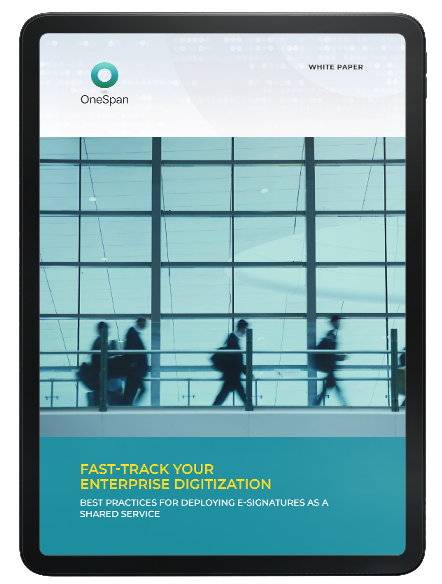How to Use Electronic Signature in Banks: Top 5 Use Cases

Electronic signatures are an essential part of an enterprise digitization strategy. Among financial institutions (FIs) of all sizes, there is tremendous interest in removing paper from business processes and accelerating your digital transformation. Retail and commercial banks, credit unions, lenders, and many other financial services organizations in the banking industry are adopting e-signatures for a variety of use cases. As digitization efforts mature and FIs realize the benefits in customer experience, compliance, reducing inefficiencies, and reducing operational costs, they are expanding beyond early applications and looking for ways to rapidly extend the benefits of signature software to every business line, channel, and area of the organization.
For those just getting started with e-signature, the top questions are, “How should I use electronic signature?” and “Which process will give us the most ROI?” Ultimately, all business lines and channels have processes that are good candidates for e-signatures and digital signatures; the choice of use cases is as individual as the bank. That said, here are the top five common use cases for e-signature.
How to Use Electronic Signature: Top 5 Use Cases
1. ACCOUNT OPENING
Offering a fully digital account opening and onboarding process from anywhere, at any time, has become a competitive advantage. The challenge is implementing an end-to-end digital process, so the customer no longer needs to make a physical visit to the branch to sign documents or present a physical ID document. According to Sr. Analyst Tiffani Montez at the Aite Group, account opening processes that are only partially automated lead to high drop-off rates – as high as 65% - 95%, depending on the product. This means that the majority of applicants abandon the online process and either switch to another channel (e.g., branch or call center) or look for another financial institution that enables them to complete the application process remotely.
The good news is new and innovative approaches to digital fulfillment with e-signature and identity verification technologies present an opportunity to eliminate the need for in-branch verification and signing. And financial institutions are rapidly adopting these technologies. In 2017, Celent Research published a report on BMO Bank of Montreal’s e-signature deployment. The bank’s first electronic signature use case was onboarding. “According to BMO’s Annual Report, the launch of a contextual and simplified digital account onboarding is a first-of-its-kind service in Canada. BMO customers can quickly search, select, and open an account on their smartphones in under eight minutes.” BMO’s mobile customer onboarding has been in production since 2016.
Remote mobile e-signing is possible even when online account openings require a hand-scripted signature for compliance purposes. In 2015, top banks and financial services firms began testing mobile signature capture in the field. One global bank launched a pilot to test mobile account openings at airport kiosks. The bank developed a dedicated iPad app, with e-signatures integrated directly into the app, so the entire process remains digital. The bank had been using the same trusted deposit account opening process for many years, but when it came time to adapt the process to the iPad, the team used the opportunity to eliminate unnecessary steps and build a streamlined mobile experience.
Banks report that paperless account opening workflows dramatically improve the first experience with the customer by removing any need to wait while documents are printed or errors corrected. If done remotely, there is also the added benefit of enabling the customer to choose when and where they transact with the bank.
2. LENDING
Within lending, the leading strategy on how to use electronic signature is with consumer and small business loans and retail financing. E-Signatures, e-forms, and digital processes are being used online, in the call center, and in the branch for signing loan applications and finance contracts as well as for electronically delivering the many consumer disclosures at the heart of these processes.
The value is simple. Keeping transactions completely digital and applying workflow rules eliminates risk associated with document errors such as missing signatures and data. E-Signatures also remove the painful effort and poor customer experience involved in document rework – that is, calling a borrower back to re-sign paperwork that was not completed correctly the first time.
U.S. Bank has nearly eliminated loan exceptions by incorporating e-signatures into their consumer and business loan processing, which was deployed across more than 3,000 retail branches in 2011. As a result, the bank has cut the majority of document handling costs, exceeded compliance requirements, and improved customer experience.
“We started at 70% of all loan account openings having e-signatures, and within a year we were up to 85%, which is where we stayed”, says Ron Eddy, an associate vice president for technology and operations at U.S. Bank.
But the most e-signature activity is taking place in the online channel, where the need for immediacy is greatest to offset high abandonment rates on loan applications due to long paper processing times. In the online channel, it is common to see customer adoption of e-signatures hovering close to 100%. For student loans, one lender went live with e-signing at the peak of their loan season, and overnight attained a 99.9%
adoption rate that has since held steady.
Globally, banks and retail finance providers are experiencing similar benefits. For the UK’s Secure Trust Bank, as well as global finance provider Hitachi Capital, offering e-signature capability enables their retail partners to execute financing at the point of sale with the speed and simplicity of an online credit card transaction. The customer clicks a few buttons to sign their name on a tablet or other device in the store, and the transaction is closed. This is a major competitive advantage considering that it gives banks and financial services companies the ability to close the sale while interest from the customer is high.
There are similar benefits in commercial lending. Wright-Patt Credit Union (WPCU), one of the 50 largest credit unions in the US, turned to cloud technologies to help automate their commercial lending process. The credit union leveraged the e-signature integration between OneSpan Sign and nCino and in doing so, their Commercial Lending team was truly able to harness the efficiencies of an end-to-end digital process. In less than one year using the combined solution, WPCU has tripled commercial loan volume from 30 to 100 loans per month with the same core team, while also streamlining the lending experience for their business members. Benjamin Miller, WPCU Commercial Portfolio Analyst, says: “Our coordinators, the ones who put together the document packages and send them out electronically, get the most excited about it.” Where WPCU’s Commercial Lending team used to spend 22 minutes preparing paperwork for signing by the member, they have now cut that time by 50% with the digital process. Their lenders have also seen significant time savings. On paper, lenders would spend on average 54 minutes conducting a loan closing “that now takes no time at all on their part.”
Enabling remote e-signature capability for mobile lending transactions is also a growing focus, as FIs look to attract the growing segment of mobile-first customers. Overall, our customers report that transforming their lending processes with e-signatures has:
- Cut the application process from 8 days to 24-48 hours
- Saved $1 million in annual scanning and imaging costs on 26 million pages of loan documents
- Reduced document errors by 90%
- Removed 80 % of document handling costs
- Streamlined the workflow from 16 steps to 4 steps
- Enabled one bank to redeploy 95,000 hours of bankers’ time to sell more loans
- Eliminated the need for manual back-office operations
3. WEALTH MANAGEMENT
Wealth Management is also an excellent strategy on how to use electronic signatures. The goal is to shorten the long sales process (typically involving multiple meetings and high error rates) to a single session where the paperwork is processed face-to-face with the customer.
In a recent CEB TowerGroup webcast on the topic of e-signature trends in wealth management, two themes surfaced. First, clients are looking for more simplified, digital interactions. The second is the need to equip advisors with the tools they need to provide the experience that clients want. According to CEB, “Consumer technology usage is high, but many advisors are not interacting with their clients in a digital
manner.”
In a CEB survey of financial services and wealth management firms, 32% of respondents reported that improving client onboarding from the front to back office and applying technology to improve multi-channel client engagements are the top two areas that are most critical. The survey also found that 34% of respondents prefer using client-facing portals or wealth management websites when purchasing new financial products or services and 62% of Gen X/Y clients believe technology helps them better collaborate with their financial advisor.
In 2012, RBC Royal Bank of Canada implemented e-signature technology for its wealth management line of business. Bank Systems & Technology reports that the bank’s investment advisors were losing more than 80,000 hours yearly by chasing documents and fixing mistakes such as missing signatures and data. With hundreds of mobile investment advisors across the country handling millions of paper documents while on the road, the potential for human error was great. To correct errors, the advisor would have to, for example, go back to the customer to collect missing signatures or re-work documents. E-Signatures provided the solution.
The bank’s e-signature ROI has included:
- Thousands of hours saved in sales administration, freeing advisors to focus on sales and relationship building activities
- 75% fewer document errors
- $8,000,000 in annual administrative savings
By automating its wealth management processes, RBC has also laid the groundwork for further expansion of e-signatures to other lines of business. In an interview with RBC’s former VP of digital strategy and customer experience, James McGuire, Bank Systems & Technology, explains that, “Building out the infrastructure for the solution and the workflows for the different types of transactions was the biggest challenge to the product’s launch. But now it will be much easier to bring the solution to other parts of the bank’s operations such as in branch retail transactions. The bank is already piloting the solution in some of its branches and plans to roll out the solution to its full branch network later this year.”
In wealth management, another area of interest is investment transfers. Tangerine, a division of Scotiabank, formerly ING Direct Canada, began offering e-signature capability to customers during the busiest season of the year for retirement investments. Their use case was a transfer authorization form that customers sign to move registered investments to Tangerine from another bank. Over a 6-month period, the bank saw over 1,500 transfers submitted using e-signatures. Tangerine’s customers embraced e-signature capability, with 65% choosing e-signatures over the paper process. Not one of those digital forms contained a single error. The bank experienced a 0% NIGO rate – something that simply doesn’t happen with paper.
4. RESIDENTIAL MORTGAGE
Despite the complexities of the mortgage business, the digital mortgage is gaining momentum. As more mortgages and refinances move online for increased convenience and speed, e-signatures are the ideal solution to bring the digital experience into the customer’s home and make it convenient, secure, and compliant.
Banks are integrating technologies like e-docs, e-signatures, and e-disclosures, and taking a phased approach to digitizing the many processes within the mortgage transaction. Electronic delivery of time-sensitive disclosures is one of the first steps in the mortgage process that banks and lenders digitize.
For example, Wells Fargo has enhanced its digital mortgage process by enabling eDelivery of disclosures for home equity line of credit (HELOC) applications. This proved to be an excellent example of how to use electronic signature, because this provided customers the ability to review disclosures through a web or mobile browser and keep the process moving forward without having to wait for a paper package to be delivered through the mail. Next, Wells Fargo extended eDelivery of disclosures to all residential home mortgage applications. In addition, the bank delivered residential mortgage disclosures to mobile phones. Then in 2015, Wells Fargo provided customers who opt for a paperless process, the ability to electronically sign their mortgage application.
Beyond regulatory pressures, the two main drivers to digitize mortgages are customer experience and competition from non-bank lenders. Non-bank lenders are increasingly adopting technologies, such as e-signature, to become more agile and gain a competitive edge. Clearly, customers want the convenience of online transactions. They are rewarding financial services providers who offer them the ability to use a mobile device to communicate with their loan officer, upload documents, electronically accept disclosures, and e-sign forms.
5. COMMERCIAL BANKING & TREASURY MANAGEMENT
Improving the customer experience for commercial lending and treasury management is driving FIs to find ways to make it easier to do business with commercial customers outside the branch.
This Chicago-based bank is a good example. According to American Banker, e-signature has cut the time it takes to get customers signed up for treasury management services. “The bank aimed to trim the time and expense it took to onboard the services for clients, a previously prolonged process in which customers had to apply their wet ink signatures to paper documents received via Fedex or print out, sign, and return PDFs sent via email.”
"Now they can get the email in a minute, and if they click and complete it, the whole process can take 10 minutes," says Anne C. Doligale, senior vice president and certified treasury professional at the bank. "It just depends on how quickly they get it signed." The bank has since incorporated the OneSpan Sign cloud service into all treasury management operations, including collections, disbursements, concentration, investment, and funding activities.
For another bank, the Treasury Management Services Master Agreement was a good starting point. This regional bank uses nCino, a cloud-based bank operating system built on the Salesforce.com platform. To get up and running quickly with e-signature, their starting point was the pre-integrated OneSpan Sign for Salesforce connector, which enables a Salesforce administrator within the bank to easily install the connector and add e-signature capability to Salesforce in minutes, without any coding. This way, bankers can begin sending documents for signature immediately, directly from within their CRM platform.
Another area of interest is ACH processing. For processes such as an ACH withdrawal from a consumer’s bank account, businesses need a convenient way for the consumer to sign the bank’s authorization form – from any location and device. The problem with paper is the consumer has to either be on-site to sign the form, have access to a fax, or make time to get to the post office. However, by keeping the process digital and making it convenient for consumers to sign electronically on a smartphone, businesses can obtain the signed authorizations faster, which prevent abandonments and improves cash flow for the business. By adding e-signatures to this process, one bank was able to offer their business customers a significantly better experience at minimal cost and with almost no involvement from their IT department.
CONCLUSION
There are numerous examples across the financial services industry for how to use electronic signature. Some FIs start by introducing e-signatures as part of a branch transformation initiative. Others begin in the online channel with high volume, self-serve transactions. One global bank’s wealth management line of business first introduced e-signatures to their field sales channel. Once they had demonstrated success and proven the ROI, they continued to extend the technology to other business lines for remote account openings, e-contracting and more, as part of an enterprise digitization strategy.
Many banks are implementing e-signature solutions as a shared service across the organization. While one line of business may need an immediate solution for electronically signed documents, the organization likely has an enterprise need for digital business processes. Like other capabilities, such as centralized accounting or HR services, e-signatures are increasingly implemented as a service that can be easily accessed by any division. This breaks down silos internally, saves on developer time, streamlines roll-out, and creates a consistent user experience.
If you want to go digital and offer e-signature functionality as a shared service for your signing processes, it can be done, no matter how varied your business needs and requirements. To learn more, download this white paper: Fast-track Your Enterprise Digitization: Best Practices for Deploying E-Signatures as an Enterprise Service.










